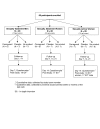Acceptability of Carraguard, a candidate microbicide and methyl cellulose placebo vaginal gels among HIV-positive women and men in Durban, South Africa
- PMID: 17900337
- PMCID: PMC2089066
- DOI: 10.1186/1742-6405-4-20
Acceptability of Carraguard, a candidate microbicide and methyl cellulose placebo vaginal gels among HIV-positive women and men in Durban, South Africa
Abstract
Background and methods: When on the market, microbicides are likely to be used by individuals who do not know their HIV status. Hence, assessment of safety and acceptability among HIV positive men and women is important. Acceptability of Carraguard, the Population Council's lead microbicide candidate was assessed in a Phase I safety study among healthy HIV-positive sexually abstinent women and men, and sexually active women (20 per group), in Durban, South Africa. Participants were randomized to use Carraguard gel, placebo gel, or no product. All women in the gel arms applied 4 ml gel vaginally every evening for 14 intermenstrual days (women in the sexually active group inserted gel within 1 hour prior to sex on days when sex occurred), and sexually abstinent men applied gel directly to the penis every evening for 7 days. Acceptability was assessed by face-to-face structured questionnaires and semi-structured in-depth interviews with all participants. Gel use questions were applicable to participants in the gel arms only (13 sexually abstinent women, 14 sexually active women, and 13 abstinent men).
Results: Overall, 93% of the women liked the study gel (Carraguard or placebo) very much, 4% disliked it somewhat, and 4% were neutral. 15% of men and women disliked the gel's color, smell, or packaging. Most women and men reported never experiencing pain or irritation during or after gel application. Although over two thirds of the women preferred some lubrication during sex, some of the women felt that the gel was frequently too wet. Twenty-one percent of women and 42% of men said they felt covert use of a microbicide would be acceptable. Over 60% of women and men would prefer to use a microbicide alone instead of using it with a condom.
Conclusion: Acceptability of Carraguard among HIV-positive women and men in Durban was good. The wetness experienced by the women may be attributed to the delivery of gel volume. The applicator was designed to deliver 4 mls whereas in fact between 4 ml to 5 mls were actually dispensed. Condom migration in the event of a partially effective product is of concern.
Figures
References
-
- Report on the Global AIDS Epidemic 2006. Joint United Nations Programme on HIV/AIDS (UNAIDS) and World Health Organization (WHO), December 2006 http://www.unaids.org/en/HIV_data/2006GlobalReport/default.asp
-
- Coggins C, van de Wijgert J. BETA. Vol. 15. Spring; 2002. Microbicides to prevent heterosexual transmission of HIV: ten years down the road; pp. 23–28. - PubMed
-
- El-Sadr WM, Mayer KH, Maslankowski L, Hoesley C, Justman J, Gai F, Mauck C, Absalon J, Morrow K, Massa B, Soto-Torres L, Kwiecien A. Safety and acceptability of cellulose sulfate as a vaginal microbicide in HIV-infected women. AIDS. 2006;20:1109–16. doi: 10.1097/01.aids.0000226950.72223.5f. - DOI - PubMed
-
- van de Wijgert JannekeHHM, Braunstein SarahL, Morar NeethaS, Jones HeidiE, Madurai Lorna, Evans Strickfaden TammyT, Moodley Manivasan, Aboobaker Jamila, Ndlovu Gugulethu, Ferguson TajaM, Friedland BarbaraA, Hart ClydeE, Ramjee Gita. Carraguard Vaginal Gel Safety in HIV positive women and men in South Africa. JAIDS. - PubMed
LinkOut - more resources
Full Text Sources
Other Literature Sources


